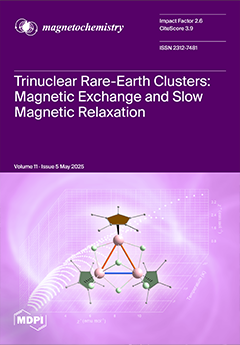Organometallic rare-earth complexes have attracted considerable attention in recent years due to their unique structures and exceptional magnetic properties. In this study, we report the synthesis and magnetic characteristics of a family of monopentamethylcyclopentadienyl-coordinated trinuclear rare-earth hepta-chloride clusters [(Li(THF)(Et
2O))(Cp
*RE)
[...] Read more.
Organometallic rare-earth complexes have attracted considerable attention in recent years due to their unique structures and exceptional magnetic properties. In this study, we report the synthesis and magnetic characteristics of a family of monopentamethylcyclopentadienyl-coordinated trinuclear rare-earth hepta-chloride clusters [(Li(THF)(Et
2O))(Cp
*RE)
3(
μ-Cl)
4(
μ3-Cl)
2(
μ4-Cl)] (
RE3: RE =Y, Gd, Tb, Dy, Ho, Er, Tm, Yb, Lu; Cp* = pentamethylcyclopentadienide). These clusters were synthesized by reacting LiCp* with RECl
3 in a 1:1 molar ratio within a mixed solvent system (THF: Et
2O = 1:9), resulting in high solubility in common organic solvents such as DCM, THF, and Et
2O. Magnetic studies conducted on these paramagnetic clusters reveal the coexistence of ferromagnetic and antiferromagnetic superexchange interactions in
Gd3. Additionally,
Dy3 exhibits both ferromagnetic and antiferromagnetic intramolecular dipolar interactions. Notably, slow magnetic relaxation was observed in
Dy3 below 23 K under a zero DC applied field with an energy barrier of 125(6) cm
−1.
Full article





